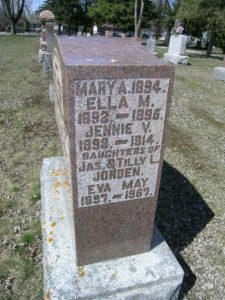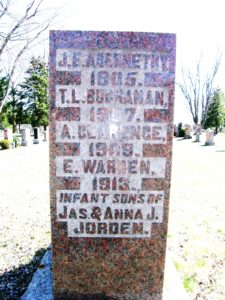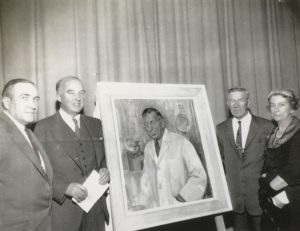“Jane was really Jennie”
Dr. Peter Banting
Bob Banting
December 5, 2007
Canadian hero, Sir Frederick Grant Banting was born on a 100-acre farm (5116 Sir Frederick Banting Road, New Tecumseth), near the rural Town of Alliston, Ontario on November 14th 1891. Fred’s parents, of British and Scottish descent on his mother’s side, were born in the area. The Banting homestead is located about an hour’s drive north of Toronto, Ontario.
Fred grew up on the farm, doing typical farm chores[i] and playing[ii] with his friends in the area. One playmate was a girl who lived on the other side of the road. She was given the alias Jane,[iii] by previous authors. Her real name was Jennie Victoria Jorden. She became a diabetic and Fred observed her slow death when she was only 14. Fred watched her lose energy and weight. He visited her on the porch of her home. Sadly, he was a bearer at her funeral. Lessons[iv] learned in this boyhood environment would be a foundation for what happened next.
It is well known that Fred Banting along with Charles Best went on to discover insulin on July 30, 1921. It was Fred Banting’s idea that kick-started the discovery of insulin. It was his knowledge of farm animals that led him to use fetal calf pancreas to produce insulin in large volumes. Perhaps his experience with Jane also had an influence on his discovery of the hormone that could have saved her life.
Fred left the Banting homestead to attend medical school at the University of Toronto. This was only a short train ride away, so Fred often returned home. The medical school quickly exhausted life-start funds that William and Maggie, Fred’s mother and father, gave to their children.
Banting’s medical class, called 1T7, became involved in World War I medical support. Fred was quick to enlist. He tended to battle casualties on the front line, was wounded and was decorated with the Military Cross.
On his return to Canada Fred was completely broke. His family had loaned him money to complete medical school. Now they extended these loans further to help him set up a medical practice in London Ontario. But this practice made his financial situation much worse. He only saw a few patients and had little income. To survive, he took a part-time medical lectureship at the University of Western Ontario.
On October 31, 1920, after spending the evening reading research papers and preparing a lecture for the following day, he awoke from a restless sleep with an insight. At 2:00 a.m. he wrote the words that would unravel the diabetes puzzle and stifle its certainty of death.
What led him to this insightful revelation? What drove him on through the obstacle-filled discovery period? Why did he persist, even though he was broke and received no salary from the University of Toronto? Perhaps it was Fred Banting’s first-hand experience of watching his young friend Jennie’s slow death that was the stimulus for his dedicated persistence.
Fred’s family in Alliston continued to provide him with financial aid for many years. Why was this? Perhaps their awareness of the wasting death of their neighbours’ daughter had something to do with their encouragement and financial support for Fred’s work.
Sadly, the Jorden family not only lost Jennie to diabetes. Her sister also suffered the same fate. Tragically, one after another, all but two of the remaining Jorden children died from other diseases. Out of respect for their neighbours Fred, his siblings and parents never widely disclosed this story. It remained their secret. However, Fred did tell Charles Best and Fred Hipwell, from Alliston was familiar with Jennie’s story.
The Jorden family story is now a matter of public record. Census records, death documents and land records have revealed the whole story. See Jennie’s death record below. These along with the Jorden family gave stone, located in Alliston’s Union Cemetery,[v] present the story of a family tragedy.
Two of the nine Jorden children lived long lives. One was James, who is not named on the Alliston grave marker and the other was Eva May Jorden. She resided in Alliston for the latter part of her life. Fred Banting’s nephew and Banting family historian, Edward Banting, has kept her memory alive in his diary thanks to Eva May. Edward and his wife Louise met Eva at social events. They discussed Jennie who once lived near the Banting Homestead. But as now revealed, the story of “Jane” may add another dimension to the story of Fred Banting’s conquest of the dreaded disease, diabetes.
Eva May is on the bottom of the stone in this picture while her sisters and Jennie Victoria are listed above her name.

The next picture shows the other side of the stone. All victims of communicable diseases and diabetes.

A further proof of this story came on December 8 1955, when a portrait of Frederick Grant Banting was officially unveiled and placed in the lobby of the Banting Memorial High School (BMHS) in Alliston, Ontario, by Mrs. Lillian Hipwell, and Dr. C.H. Best. The painting referenced one of the last known photographs of Fred taken by Mrs. Hipwell’s husband, Dr. Fred W.W. Hipwell, a Banting cousin and University of Toronto Meds 1T7 classmate. The art unveiled was painted Toronto artist Dorothy Stevens. The portrait continues to grace the front lobby of the school.
In this photo of the event, supplied by an Alliston historian, are:
- to R. B.J. McCausland, Principal, BMHS, Dr. Charles H. Best, William Thompson Banting, older brother of Fred Banting and Mrs. Lillian Hipwell.

Two things happened after this event that were of historical importance:
First, a speech by Charles Best was recorded in the American Diabetes Association “Forecast” July/August 1956. It contained key details of the early Isletin (Insulin) research in Toronto. He noted that both he and Banting had early experiences with diabetics.
Second, Thompson Banting (he went by his middle name), Fred’s older brother and his wife Lena née Knight invited Charles Best and his wife Margaret née Mahon to have tea at the Banting Homestead after the ceremony. At the time, Thompson, was the only remaining, living child of William Banting and Margaret Grant. Thompson did many interviews with authors and historians, making them fully aware of Fred Banting’s early life. The Banting’s took their quests by car on a tour of the area.
When Charles returned to Toronto, he began writing a published paper (see below add reference to paper here) on the Discovery of Insulin research. In the preamble of the paper[vi] he described his trip to Allison. He records that both Fred and himself had early childhood experiences with diabetic persons.
In his record Best points out that Thompson and Lena took he and his wife on a drive past the place where Jennie once lived. Fred never discussed Jennie Jorden nor did most of the family of nine children was nearly completely wiped out by communicable diseases and diabetes.
As Best recorded, it: “For example, some of Banting’s close friends knew that a part of his motivation stemmed from an interest in a schoolmate in Alliston, Ontario, who died of diabetes. Recently my wife and I went to Alliston and helped to dedicate a portrait of Fred Banting which was to hang in the entrance hall of the Banting Memorial High School. We saw again the farm where he was born; where I first met his fine parents; and where our friend, Fred’s older brother Thompson Banting, now lives. We drove along the road where Fred Banting walked to school and passed the house which, we were told, was the home of the diabetic little girl.”
Another proof comes from Fred Banting’s association with Canadian Art and Artist A. Y. Jackson. He penned a small book called Banting as an Artist[vii]. In the introduction of the book by Frederick Hipwell, Banting’s cousin, a doctor, and lifelong friend Fred Banting writes a paragraph about he and others meeting with Fred Banting in England in early 1918. They were waiting for passage back to Canada after the Great War. So, prior to any insulin research in 1921, Fred Banting discussed diabetic issues with other peers. Fred Hipwell says that his thoughts were driven by his experience with Jennie in Alliston.[viii]
But as now revealed, the story of “Jane” may add another dimension to the story of Fred Banting’s conquest of the dreaded disease, diabetes.
[i] Seale Harris, M.D., Banting’s Miracle – The Story of the Discoverer of Insulin, J.B. Lippincott Company, Montreal, 1946, pp. 1-15
and
I.E. Levine, The Discoverer Of Insulin – Dr. Frederick G. Banting, The Copp Clark Publishing Co. Limited, Toronto, 1959, pp. 11-31
[ii] Lloyd Stevenson, M.D., Sir Frederick Banting, The Ryerson Press, Toronto, December 1946, pp. 1-16
[iii] I.E. Levine, Op. Cit., pp. 17-22.
[iv] Seale Harris, M.D., Op. Cit., pp.1-2
[v] Gravestone pictures of Jennie Victoria Jorden.
[vi] 1-In the book Selected papers of Charles Henry Best. U of T Press, 1963. The Discovery of Insulin, Pages 302-310
[vii] In the book Banting as an Artist. By A.Y. Jackson, Ryerson Press, 1943
[viii] Sir Frederick Banting K.B.E. A Memoir by Frederick W. W. Hipwell. Pages 7-10
Credit for the death record: Ancestry.com
